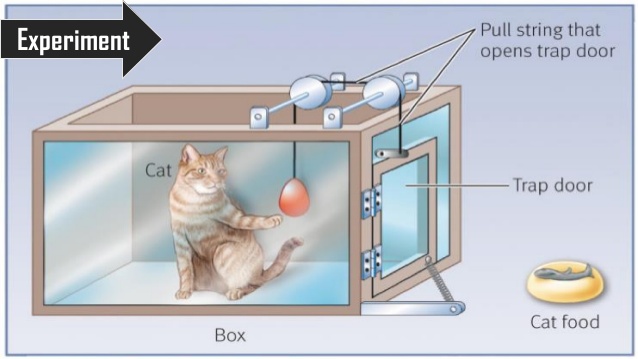Trial And Error Theory – Psychology Notes For – W.B.C.S. Examination.
পরীক্ষা এবং ত্রুটির তত্ত্ব – মনোবিজ্ঞানের নোট – WBCS পরীক্ষা।
Thorndike placed a hungry cat inside a puzzle box, and a plate of fish was kept outside the box. It was impossible for the cat to get to the plate, unless it could open the door and get out. Thorndike had arranged the puzzle box such that, the cat either had to pull a loop or press a lever in order to open the door.Continue Reading Trial And Error Theory – Psychology Notes For – W.B.C.S. Examination.
Initially, the cat moved randomly inside the box; biting and clawing at the bars, thrusting its paws and trying to squeeze out of the box. After several minutes of trying these ineffective responses, the cat accidentally pulled the loop. Having hit the correct response, the cat managed to get out and it was awarded with a small piece of fish.
The cat was placed inside the box again. This time around, the cat took less time to pull the loop. The exercise was continued repeatedly. It was seen that as the number of trials increased, the time taken to pull the loop decreased. As the response latency decreased, the cat finally learned the trick; it then pulled the loop as soon as it was put in the box and managed to get out.
The term “Trial and Error Learning” was then introduced as the number of trials resulted in decreased number of errors.
Basic Conditions for Trial and Error Learning
Drive is an essential factor that triggers the various conditions for this phenomenon. If we look at the experiment above, hunger was the cat’s drive which stimulated it into trying out various responses until it finally learned the trick. Drive motivates to learn and make organism active to learn.
Blockade/barrier in satisfaction of drive
Trial and Errors occur only when there is barrier or blockade in between hunger and food. In the above experiment, satisfaction of hunger was only possible through consumption of food, but there was barrier in achieving the food. The barrier was the problem which needed to be solved in order to receive food. The attempts to solve the problem led to trial and error activities.
Random Activities
Accidental Success
The first time an organism gets something right after repeated trials is always accidental, hence the term, accidental success. For instance, the first time the cat managed to pull the lever was accidental success.
Selection of Right Response
Accidental success is not the ultimate solution to any problem. The organism keeps trying out its previously tried out random attempts until it stumbles upon the right response. With repeated trial, the solution can be isolated.
Fixation of the Right Response
It’s the final stage of learning. The organism having identified the right response stays fixed on it, which lets the organism to act immediately when presented with the same situation. For instance, the cat managed to pull the loop immediately once it had, say, mastered the trick, or reached the final stage of Trial and Error Learning.
Laws of Trial and Error Learning
Law of Exercise
Law of exercise is a fundamental basis of trial and error learning since organism learns as a result of repeated trials/practice/exercise. The law can be subdivided into two parts:
Law of Use: If any action is repeated by an organism in certain condition, learning occurs.
Law of Disuse: If the action is not repeated by an organism, there will be no learning.
Law of Effect
Simply put, law of effect states that satisfaction lead to the repetition of the action. Reward causes satisfaction. Thorndike stated that satisfying state of affairs is a key to learning, defining it as
One which the animal does nothing to avoid, often doing such things as to attain and preserve it.
If the reward satisfies, the exercise then strengthens the connection, and the connection is weakened when the exercise leads to undesirable outcomes. The reward must satisfy, and the greater reward has greater effect on learning.
Law of Readiness
Readiness is the function of motivation, which is guided more by law of reward. The law states that when conduction cells are prepared for particular action, this will lead to satisfaction.
Our own publications are available at our webstore (click here).
For Guidance of WBCS (Exe.) Etc. Preliminary , Main Exam and Interview, Study Mat, Mock Test, Guided by WBCS Gr A Officers , Online and Classroom, Call 9674493673, or mail us at – mailus@wbcsmadeeasy.in
Visit our you tube channel WBCSMadeEasy™ You tube Channel
Please subscribe here to get all future updates on this post/page/category/website



 Toll Free 1800 572 9282
Toll Free 1800 572 9282  mailus@wbcsmadeeasy.in
mailus@wbcsmadeeasy.in


















































































































